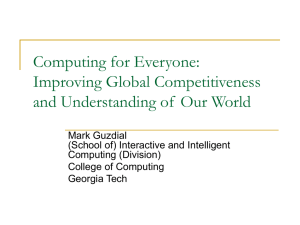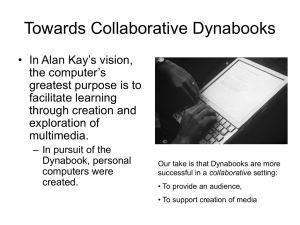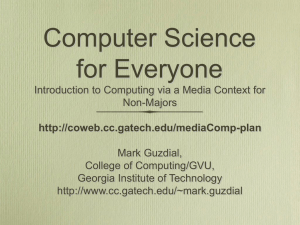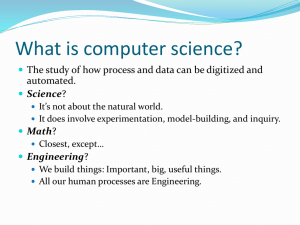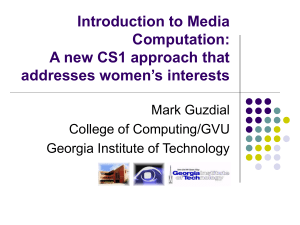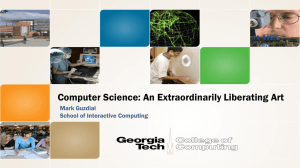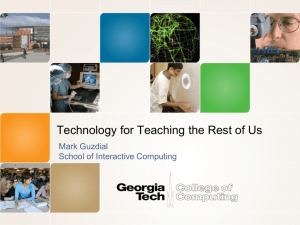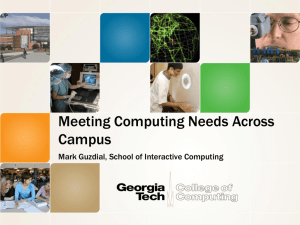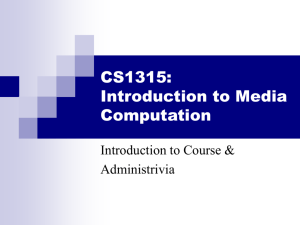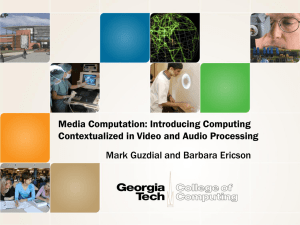IntroToMediaComp-ICE@GT-July05 - Coweb
advertisement
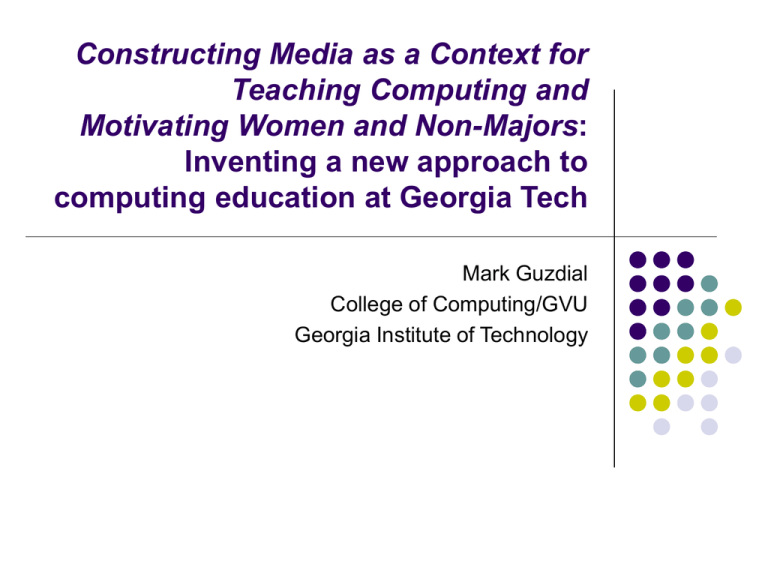
Constructing Media as a Context for Teaching Computing and Motivating Women and Non-Majors: Inventing a new approach to computing education at Georgia Tech Mark Guzdial College of Computing/GVU Georgia Institute of Technology Story Creating ubiquitous computing education First course: Introduction to Media Computation It’s about context What students do in it The role of collaboration Second course: Representing Structure and Behavior Next steps Beyond the course: A path into CS Beyond Georgia Tech and undergrads The Computer Science Undergraduate Degree is in Deep Trouble We’re losing students, at an increasing rate. Women and minority percentage of enrollment dropping High failure rates in CS1 (35-50% or more) Fewer applications into CS: “All programming jobs going overseas” Research results: “Tedious,” “boring,” “lacking creativity,” “asocial” All of this at a time when we recognize the critical role of IT in our economy, in all jobs Strategy: Make CS education ubiquitous Motivate non-CS students to care about computing. Create non-traditional courses, minors, and nontraditional paths into CS Reach out beyond Georgia Tech Make it relevant, social, and creative. Our Three Introductory Courses (CS1’s) CS1321 Introduction to Computing Traditional CS1 for our CS majors, Science majors (math, physics, psychology, etc.). Was in Scheme, now in Python. CS1371 Computing for Engineers CS1 for Engineers. Same topics as CS1321, but using MATLAB with Engineering problems in homework and examples. CS1315 Introduction to Media Computation CS1315 Introduction to Media Computation Started with 121 students in Spring 2003, and averaging 300/term since then 2/3 female in Spring 2003 MediaComp Overall, CS1315 has been 51% female Required in Architecture, Management, Ivan Allen College of Liberal Arts, and Biology Focus: Learning programming and CS concepts within the context of media manipulation and creation Converting images to grayscale and negatives, splicing and reversing sounds, writing programs to generate HTML, creating movies out of Web-accessed content. Computing for communications, not calculation def clearRed(picture): for pixel in getPixels(picture): setRed(pixel,0) def greyscale(picture): for p in getPixels(picture): redness=getRed(p) greenness=getGreen(p) blueness=getBlue(p) luminance=(redness+blueness+greenness)/3 setColor(p, makeColor(luminance,luminance,luminance)) def negative(picture): for px in getPixels(picture): red=getRed(px) green=getGreen(px) blue=getBlue(px) negColor=makeColor(255-red,255-green,255-blue) setColor(px,negColor) Relevance through Data-first Computing Real users come to a user with data that they care about, then they (unwillingly) learn the computer to manipulate their data as they need. “Media Computation” works like that. Students do use their own pictures as starting points for manipulations. Starting in the second week of the course! Some students reversed sounds looking for hidden messages. Impact on Student Retention Enrollment Success Rate Georgia Tech’s CS 1 2000 - 2002 (average) 930 71.2% Media Computation Spring 2003 120 90.0% Fall 2003 303 86.5% Spring 2004 395 86.9% Summer 2004 120 73.3% Fall 2004 366 80.3% Spring 2005 317 84.5% Since Spring 2004, the developers aren’t the teachers. We are getting transfers into the CS major. For traditional CS1, Sp2005 had 95 students, 70.0% success rate. Engineering CS1 Spring 2005: 833 students, 76% success rate. Were Students Motivated and Engaged? Homework assignments suggest they were. Shared on-line in collaborative web space (CoWeb) Some students reported writing programs outside of class for fun. Example Student Work -Shared on the CoWeb Gallery Example Student Work -Shared on the CoWeb Gallery The author of this collage via IM as soon as she was done: “Well, I looked at last years’ collages, and I certainly can’t be beat.” Example student work - Movies and audio homework Soup Stephen Hawking Study-Abroad CS Role of the Homework “Galleries” Q: What do you think about the homework galleries on theCoWeb? Student 4: It's nice to see other people, like what they did with it… And there is no better feeling than getting something done and knowing that you've done it right. Student 3: I don't ever look at it [the homework gallery] until after I'm done. I have a thing about not wanting to copy someone else's ideas. I just wish I had more time to play around with that and make neat effects. But JES [Jython Environment for Students---the programming environment created for this class] will be on my computer forever, so…the nice thing about this class is that you could go as deep into the homework as you wanted. So, I'd turn it [the homework assignment] in, and then me and my roommate would do more after to see what we could do with it. Follow-up Survey: Did it have a lasting impact? In Spring 2004, conducted an email survey with students from Spring 2003 (n=120) and Fall 2003 (n=303) students. 59 responses 11 (19%) had written a Python program on their own since the class had ended. 27% had edited media that they hadn’t previously. “Did the class change how you interact with computers?” 20% said no. 80% said yes, but it was also more about changing how they thought about computers. “Definitely makes me think of what is going on behind the scenes of such programs like Photoshop and Illustrator.” “Other than making me a little more aware about what I can make the computer do, it hasn't changed the way I particular interact with technology. Yet I am uninterested in this field. However, I now have a MUCH better understanding of the people who are interested in this field, how they view things, and how to interact with them more easily. For this, I appreciate the CS class greatly.” Second course: CS1316 “Representing structure and behavior” Driving question: “How did the wildebeests stampede in The Lion King?” 31 students, 75% female, 91% success rate. Similar Assignments, but with Objects * Sounds/Music in Trees and Lists Assignment: Create music by repeating and weaving nodes. Canon Swan Bells Beyond the courses: An alternative path and a CS minor The two courses (Introduction to Media Computation and Representing Structure and Behavior) are now accepted as pre-req to our traditional second course. Margolis and Fisher’s “alternative path” We have now defined a CS minor Created new BS in Computational Media Joint with School of Literature, Communications, and Culture 58 majors in first year, 24% female Beyond GT Versions of Media Computation appearing at other institutions Gainesville College (2 year in Ga.) has been offering the course for over a year. Just moved their major’s CS1 to Media Computation Denison University is first trial of our Java version. University of Illinois at Chicago, Australian National U., U. California Santa Cruz, DePauw, Brandeis (in Scheme), Georgia Perimeter College and University of Maryland at College Park (in Java) (using some of our materials). Gainesville College Results Success rates at Gainesville College before and with Media Computation class. ENROLLMENT SUCCESS RATE 28 70.2% Summer 2003 9 77.8% Fall 2003 39 84.6% Spring 2004 22 77.3% Summer 2004 11 90.9% Gainesville’s CSCI 1100 Average 2000 – 2003 Media Computation “Would you like to take more courses in CS or Media Computation?” GEORGIA TECH GAINESVILLE CS Media Comp CS Media Comp Strongly Agree 4.1% 16.1% 6.2% 12.5% Agree 19.3% 26.5% 25.0% 37.5% Neutral 23.8% 23.3% 43.8% 18.8% Disagree 37.7% 22.9% 25.0% 25.0% Strongly 15.2% Disagree 11.2% 0.0% 6.2% Summary CS Education is in a sorry state, and fixing it is important to us and others Media Computation seems to be a useful context to motivate student retention and learning. Just started on evaluation: learning assessment, impact of collaborative policies on student motivation, impact on long term choices about CS learning Bottom line: Context is a win. Broad implications for computing as part of a general, liberal education. Acknowledgements Faculty Collaborators: Barbara Ericson, Charles Fowler (Gainesville) Course Materials Development: Adam Wilson, Jason Ergle, Claire Bailey, David Raines, Joshua Sklare, Mark Richman, Matt Wallace, Alisa Bandlow, Ellie Harmon, Yu Cheung Ho, Keith McDermott, Eric Mickley, Larry Olson, Lauren Biddle Assessment: Andrea Forte, Allison Tew, Rachel Fithian, Lauren Rich, Heather Perry, Ellie Harmon, Bob Amar, Rachel Knickmeyer, Allison Tew Thanks to Bob McMath and the Al West Fund, to GVU and CoC, to the students who participated in our evaluation, and to the National Science Foundation Thank you! Mark Guzdial http://www.cc.gatech.edu/~mark.guzdial http://coweb.cc.gatech.edu/csl To get the CoWeb/Swiki software: http://minnow.cc.gatech.edu/swiki For more on MediaComp approach (including software and slides): http://coweb.cc.gatech.edu/mediacompplan
